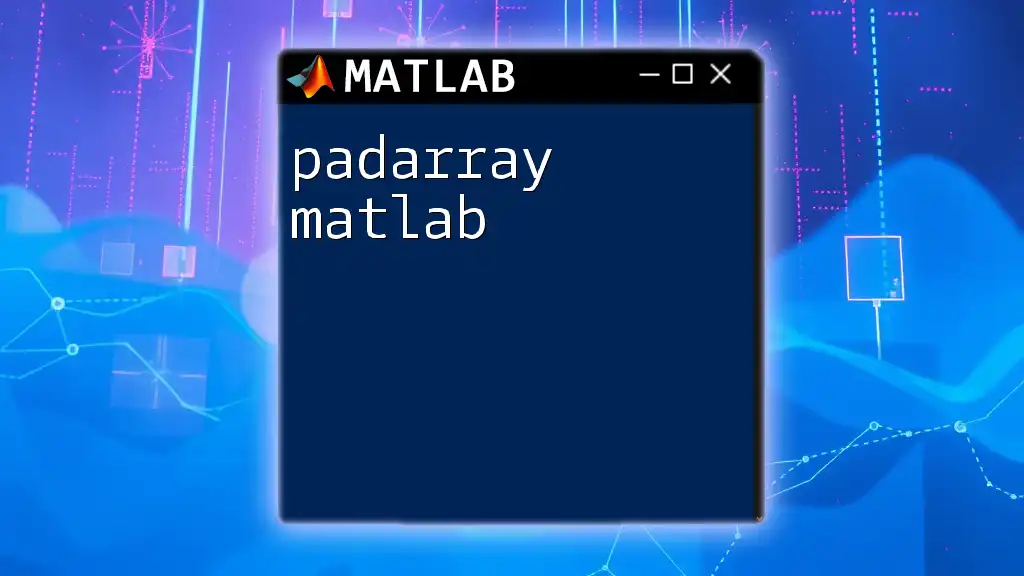The `deg2rad` function in MATLAB converts degrees to radians, making it easier to perform trigonometric calculations that require the input in radians.
Here's a code snippet demonstrating its usage:
% Convert 180 degrees to radians
radians = deg2rad(180);
disp(radians); % Output will be 3.1416
What is deg2rad?
The `deg2rad` function in MATLAB is a built-in function that converts angles measured in degrees to their equivalent values in radians. This conversion is crucial because many mathematical functions, particularly trigonometric functions, operate using radians rather than degrees. Understanding how and when to use `deg2rad` will enhance your effectiveness in performing calculations in MATLAB.

Syntax Explained
The syntax for using `deg2rad` is straightforward:
radianValue = deg2rad(degreeValue)
- radianValue: This variable will store the result, which is the angle in radians.
- degreeValue: This represents the input angle in degrees that you wish to convert.
This simplicity makes `deg2rad` particularly user-friendly, allowing quick conversions in your MATLAB scripts with minimal hassle.

Usage of deg2rad
Default Functionality
At its core, `deg2rad` performs a fundamental task—taking a single value in degrees and converting it to radians. For example:
angleInDegrees = 90;
angleInRadians = deg2rad(angleInDegrees);
In this case, when you input 90 degrees, the output will be approximately 1.5708 radians (which is π/2). This straightforward conversion exemplifies how `deg2rad` provides a quick way to handle trigonometric computations.
Vector Input
MATLAB's capability to work with arrays allows you to pass in a vector of degree values to `deg2rad` as well. This feature is particularly useful for batch processing angles in applications like simulations or graphical representation. For example:
anglesInDegrees = [0, 30, 45, 60, 90];
anglesInRadians = deg2rad(anglesInDegrees);
Here, the function will output an array of angles in radians that correspond to the input angles, thus saving you time and reducing the chance for error in manual calculations.
Matrix Input
In addition to vector inputs, `deg2rad` can handle matrices too, maintaining the structure of the original data. This application is essential when working with multidimensional data sets. Consider the following example:
anglesMatrix = [0, 30; 45, 60];
radiansMatrix = deg2rad(anglesMatrix);
The output will be a matrix where each degree measure has been converted to radians, helping you work smoothly with complex data structures.

Common Applications in MATLAB
Trigonometric Calculations
One of the main contexts in which `deg2rad` shines is within trigonometric calculations. Many of MATLAB’s mathematical functions, like `sin`, `cos`, and `tan`, expect angles in radians. Here’s a practical example:
angleDegrees = 30;
angleRadians = deg2rad(angleDegrees);
sineValue = sin(angleRadians);
In this instance, converting 30 degrees to its radian counterpart is essential for accurately calculating the sine value. This holds true for other trigonometric functions as well, enabling precise computations based on the angle provided.
Graphics and Visualizations
When creating plots or visualizations, radians play a crucial role. For instance, plotting a sine function involves converting degrees to radians, as demonstrated below:
thetaDegrees = 0:360; % Degrees
thetaRadians = deg2rad(thetaDegrees); % Radians
plot(thetaDegrees, sin(thetaRadians));
title('Sine Wave');
xlabel('Degrees');
ylabel('Sin Value');
In this example, the sine wave corresponds to a range of angles from 0 to 360 degrees. By converting these angles to radians, MATLAB is able to render the correct sine values for your plot, thus ensuring visual accuracy.

Best Practices
When to Use deg2rad
Using `deg2rad` is crucial when working within domains requiring trigonometric functions. Always remember that while degrees are commonly used in day-to-day contexts, most mathematical computations in MATLAB, especially involving trigonometry, require angles in radians.
Performance Considerations
If you’re dealing with large datasets or conducting extensive calculations, be mindful of the efficiency of your code. When converting arrays, it’s useful to take advantage of MATLAB's capabilities to process multiple values simultaneously. Utilizing `deg2rad` in vectorized operations will generally yield better performance than looping through individual elements.

Error Handling
Common Errors
While using `deg2rad`, an error may arise if the input is not numeric or doesn't conform to vector or matrix requirements. For example:
invalidInput = '30 degrees';
radiansOutput = deg2rad(invalidInput); % This will result in an error.
This will generate an error, indicating that the input type is invalid. Proper understanding and management of these errors will help you debug your code more efficiently.
Best Practices for Input Validation
To minimize errors, always validate your inputs before using them with `deg2rad`. A simple check could look like this:
if isnumeric(degreeValue) && isvector(degreeValue)
result = deg2rad(degreeValue);
else
error('Input must be a numeric vector.');
end
Validating your inputs ensures that functions execute smoothly and that you are less likely to encounter runtime errors.

Conclusion
The `deg2rad` function in MATLAB is an indispensable utility for anyone working with angles in mathematical computations. Whether you're dealing with single values, vectors, or matrices, `deg2rad` simplifies the process of angle conversion, especially in trigonometric calculations and graphical plotting. By adhering to best practices and being aware of potential errors, you can maximize your effectiveness when using this essential function.
In learning to apply `deg2rad` effectively, you'll find a smoother and more productive experience while developing your MATLAB skills. Embrace the power of built-in functions like `deg2rad`, and expand your numerical analysis capabilities.

Further Resources
For more in-depth information, check out the official MATLAB documentation on the `deg2rad` function and additional tutorials covering trigonometric functions and their applications in MATLAB. Engaging with these resources will deepen your understanding and enhance your proficiency with MATLAB programming.

FAQs
What other angle conversion functions are available in MATLAB?
MATLAB offers several angle conversion functions, including `rad2deg` which converts radians back to degrees and `atan2d`, `acosd`, etc., which provide the trigonometric functions in degrees.
How do I reverse the process and convert radians to degrees?
To convert radians back to degrees, you can use the `rad2deg` function, which operates similarly to `deg2rad`:
degreeValue = rad2deg(radianValue);
Are there any MATLAB toolboxes that enhance angle calculations?
Yes, various MATLAB toolboxes, such as the Optimization Toolbox and Signal Processing Toolbox, offer extended functions that enhance angle computations, particularly useful in advanced applications like signal analysis and robotics.

















